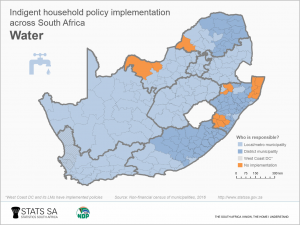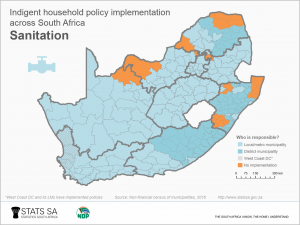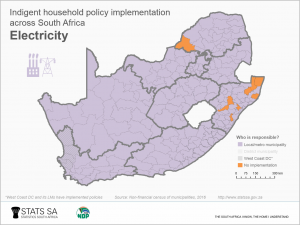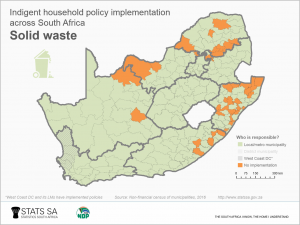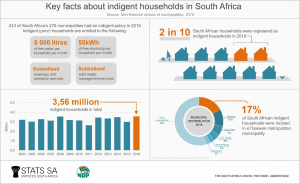
The indigent net widens, but gaps remain
Stats SA’s most recent release of its Non-financial census of municipalities (NFCM)1 report shows an increase in the number of indigent households across the country. South Africa’s 278 municipalities registered 3,56 million indigent households in 2016, the highest number on record since figures were first published by Stats SA in 2004.
To put it into perspective, 2 in every 10 households in South Africa were classified as indigent in 20162.
Municipalities adopt indigent support programmes to ensure that poor households that are unable to pay for certain basic services, have access to water, electricity, sanitation and refuse removal. Households can apply for indigent status with their respective municipalities. If a household’s application is successful – if it meets specific criteria – then it receives services for free or at greatly-reduced rates.
Each municipality is responsible for setting out its own criteria for what it defines as an indigent household, maintaining an indigent register, and providing the services which they consider feasible within financial and infrastructural constraints. Of South Africa’s 2783 municipalities, 243 had an indigent policy in place, according to the 2016 NFCM report.
But how successful have municipalities been in implementing these policies?
The answer might be more complicated than you think. There are various factors at play, the most important one being the powers and functions assigned to municipalities.
Municipalities in South Africa come in three distinct forms: metropolitan, district, and local. The 226 local municipalities, as well as the 8 metropolitan municipalities, are primarily responsible for providing various services. The 44 district councils, on the other hand, perform an oversight role and are generally not heavily involved in service delivery.
In some provinces, however, the functions between these levels have blurred. Many local municipalities in the predominantly rural areas of Eastern Cape, Limpopo and KwaZulu-Natal, for example, lack the capacity to adequately provide services and implement policies.
So even though a local municipality might have indicated a lack of implementation, the district council under which it falls may have already incorporated this role as part of its mandate.
The local municipalities shown in dark blue in the map below are those that have successfully ceded their indigent responsibilities to the districts in which they fall. This is for policies related to water.
In total, free basic water (at least 6 000 litres of free water per month for each household) was provided to 2,68 million indigent households in 2016.
There are, however, areas where both local and district municipalities have not implemented an indigent policy. These include 15 local municipalities clustered in uMkhanyakude, Harry Gwala and Amajuba districts in KwaZulu-Natal, and include Thabazimbi in Limpopo and Ratlou and Kagisano-Molopo in North West (click on the map to enlarge).
Similar gaps are evident for sanitation. In total, 2,01 million indigent households across the country benefited from free sanitation services. However, there was no implementation of a sanitation policy for areas covered by 22 local municipalities.
With regard to electricity, all local municipalities have implemented an indigent policy, with the exception of nine municipalities in KwaZulu-Natal and one in Limpopo. In total, municipalities provided free electricity (at least 50 kilowatt-hours per household per month) to 2,00 million households across the country.
Free solid waste services were provided to 2,46 million indigent households nationwide. Areas falling in 39 municipalties across the country were not covered by an implemented policy.
Indigent policies are an important tool in government’s arsenal in addressing the issue of poverty. The data indicate that although many municipalities have addressed various issues with regard to providing indigent households with some services, there are gaps where improvements can be made.
1Visit the download page for the latest Non-financial census of municipalities report here. The report and the Excel file with unit data are available.
2 The total number of households in South Africa was 16,92 million in 2016, according to the Community Survey (download the release here).
3 Note that the data were collected before the local government elections of August 2016 and thus represent the earlier local government structure consisting of 278 municipalities.
Similar thematic stories are available on Stats SA’s website and can be accessed here.


